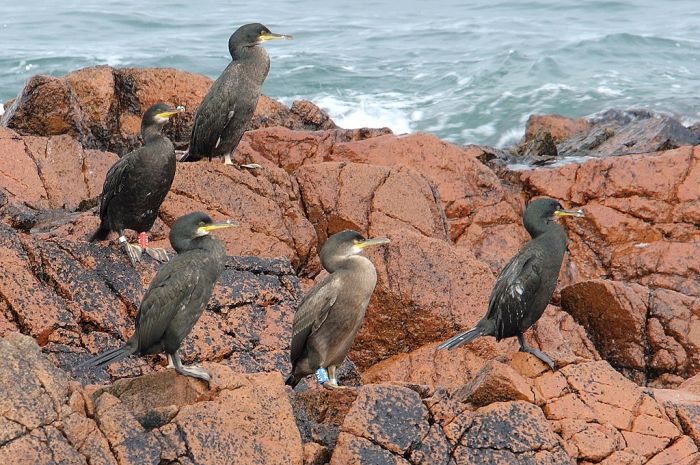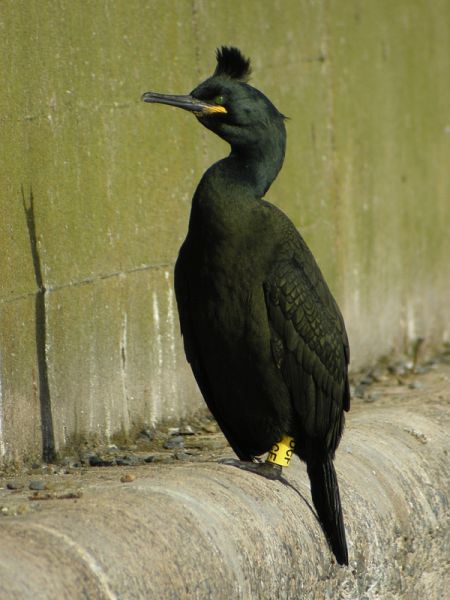
Personal Chair
- About
-
- Email Address
- jane.reid@abdn.ac.uk
- Telephone Number
- +44 (0)1224 274224
- Office Address
School of Biological Sciences, Zoology Building, University of Aberdeen, Tillydrone Avenue, Aberdeen AB24 2TZ
- School/Department
- School of Biological Sciences
Biography
***Two postdoctoral research positions and a fully funded PhD studentship in evolutionary ecology currently available with me based primarily at NTNU, Norway. Application deadline Sept 21st 2021***
Postdoctoral position in quantitative evolutionary ecology
Postdoctoral position in theoretical evolutionary ecology
PhD in evolutionary movement ecology
https://www.jobbnorge.no/search/en
I did my degree in Natural Sciences (Zoology) at the University of Cambridge, and then a PhD in behavioural ecology at the University of Glasgow. I spent two years on a Killam Postdoctoral Fellowship at the University of British Columbia, followed by a Junior Research Fellowship at Jesus College, Cambridge. I joined the University of Aberdeen as a Royal Society University Research Fellow in 2006, and was awarded a personal research Chair in Population & Evolutionary Ecology in 2014. Since 2020, I am working primarily as an International Chair Professor at the Centre for Biodiversity Dynamics, NTNU, Norway, but am happy to retain a part-time position at University of Aberdeen.
My research aim is to understand the genetic and environmental causes of variation in individual life-histories, and to understand the consequences of such variation for population and evolutionary dynamics. I achieve these aims by applying sophisticated statistical, quantitative genetic and molecular genetic analyses to long-term data from wild populations, coupled with mathematical and simulation modelling, and thereby develop and test ecological and evolutionary theory. At present, my main interests are in understanding eco-evolutionary dynamics driven by combinations of movements (i.e. dispersal and reversble seasonal migration), and links to mating system evolution.
I am committed to actively translating my research into public understanding and conservation management policy, and aim to foster processes that link science and policy outcomes.
External Memberships
NatureScot Scientific Advisory Committee
Prizes and Awards
Elected Fellow of the Royal Norwegian Society of Sciences and Letters (2021)
Elected Fellow of the Royal Society of Edinburgh (2017)
Awarded the Zoological Society of London Scientific Medal (2013)
Awarded the Marsh Award for Ornithology (2013)
- Research
-
Research Overview
My overall research aims are to understand how variation in individual life-histories arises as a function of ecological, environmental and genetic variation, and to understand the consequences of such variation for the structure and dynamics of natural populations. This work is key to understanding, predicting and managing population responses to environmental variation and change.
I have a broad, integrative approach to addressing these questions, in which I aim to harness and advance rigorous theory and analytical methods spanning evolutionary ecology, population ecology, conservation ecology and behavioural ecology and thereby utilise field data to elucidate ecological and evolutionary outcomes.
I'm currently working on three broad research areas, spanning population, evolutionary and conservation ecology:
1) Evolutionary ecology and quantitative genetics of inbreeding, mating systems and fitness, and impacts of dispersal
2) Eco-evolutionary dynamics in spatially-structured seasonally-varying environments
3) Ecological and genetic constraints on population demography and viability, and application to conservation strategy
Further details below.
Current Research
Project 1: Evolutionary ecology and quantitative genetics of inbreeding, mating systems and fitness, and impacts of dispersal.
Mating systems provide one key mechanism that translates ecological and social interactions into evolution, yet we still do not understand the forces that drive and constrain mating system dynamics in nature. Further, while the implications of dispersal in fragmented populations are understood theoretically, there are still few studies that have quantified the complex and interacting effects of inbreeding, outbreeding and gene flow on individual and population fitness in wild populations.
Accordingly, I am developing and applying sophisticated quantitative genetic analyses to an amazing long-term, multi-generation, dataset from song sparrows, alongside simulation modelling, to identify drivers and constraints on fitness in interacting females and males, and thereby test key hypotheses regarding (co)evolution of mating systems involving polyandry (female multiple mating) and inbreeding (matings among relatives) and impacts of immigrants (i.e. incoming dispersers).
Collaborators: Peter Arcese (UBC), Lukas Keller (Zurich), Pirmin Nietlisbach (Illinois)
Recent funding: European Research Council Starting Grant (2013-2018), Centre for Biodiversity Dynamics (2020-2023).
PhD student: Lisa Dickel (NTNU)
Selected recent publications:
Reid, JM, Arcese, P, Nietlisbach, P, Wolak, ME, Muff, S, Dickel, L, Keller, LF (2021) Immigration counter-acts local micro-evolution of a major fitness component: migration-selection balance in free-living song sparrows. Evolution Letters online.
Dickel, L, Arcese, P, Nietlisbach, P, Keller, LF, Jensen, H, Reid, JM (2021) Are immigrants outbred and unrelated? Testing fundamental assumptions in a wild metapopulation. Molecular Ecology in press.
Reid, JM, Arcese, P (2020) Recent immigrants alter the quantitative genetic architecture of paternity in song sparrows. Evolution Letters 4, 124-136.
Gow, EA, Arcese, P, Dagenais, D, Sardell, R, Wilson, S, Reid, JM (2019) Testing predictions of inclusive fitness theory in inbreeding relatives with biparental care. Proceedings of the Royal Society B 286, 20191933.
Reid, JM, Nietlisbach, P, Wolak, ME, Keller, LF, Arcese, P (2019) Individuals’ expected genetic contributions to future generations, reproductive value, and short-term metrics of fitness in free-living song sparrows (Melospiza melodia). Evolution Letters 3, 271-285.
Wolak, ME, Arcese, P, Keller, LF, Nietlisbach, P, Reid, JM (2018) Sex-specific additive genetic variances and correlations for fitness in a song sparrow (Melospiza melodia) population subject to natural immigration and inbreeding. Evolution 72, 2057-2075.
Reid, JM, Wolak, ME (2018) Is there indirect selection on female extra-pair reproduction through cross-sex genetic correlations with male reproductive fitness? Evolution Letters 2, 159-168.
Germain, R, Arcese, P, Reid, JM (2018) The consequences of polyandry for sibship structures, distributions of relationships and relatedness, and potential for inbreeding in a wild population. American Naturalist 191, 638-657.
I am also collaborating with Greta Bocedi, and our PhD students Max Tschol and Anders Poulsen, to understand how spatial population structure and dynamic dispersal can (theoretically) shape sexual selection and mating system evolution.
Project 2: Eco-evolutionary dynamics in spatially-structured seasonally-varying environments.
The ability of populations to persist in the face of rapid environmental change will depend on the joint potentials for phenotypic plasticity and rapid micro-evolutionary change in key traits that mediate environment-demography interactions and hence shape population dynamics. Yet, such processes have scarcely been considered with respect to a critical trait that directly links population and evolutionary dynamics in seasonally-varying environments: reversible seasonal migration.
Seasonal migration can allow individuals to increase their reproductive success and/or survival by exploiting seasonal resource peaks while avoiding seasonal ecological and environmental risks. It is increasingly clear that the expression of seasonal migration (versus year-round residence) is a highly variable individual trait in many systems, generating diverse forms of 'partial migration'. Yet the degree to which the expression of seasonal migration could show rapid plastic and/or micro-evolutionary responses to environmental variation and change, and hence drive profound population dynamic responses and forms of 'evolutionary rescue' that radically change seasonal population distributions, has scarcely been considered, either theoretically or empirically.
Over the last decade I and colleagues have invested considerable effort in collecting a major large-scale multi-year dataset on European shags that will allow us to quantify environmental and quantitative genetic (co)variation across migration, dispersal, survival and reproduction, and thereby identify eco-evolutionary causes and consequences of the variable occurrence of seasonal migration.
Collaborators: Francis Daunt, Sarah Burthe, Sarah Wanless, Mike Harris, Mark Newell (UK-CEH), with huge thanks to many volunteer field observers!
Recent funding: Norwegian Research Council FRIPRO Grant (2021-2024); Natural Environment Research Council (NERC) Discovery Grant (2018-2020); NERC Discovery Grant (2021-2024 - PI Emma Cunningham); NERC Highlight Topic Grant (2019-2023 - PI Francis Daunt); Centre for Biodiversity Dynamics (2020-2023).
Postdocs: Paul Acker (NTNU), Jennifer Morinay (Marie Curie fellow, NTNU)
Amazing field technician: Tim Morley
Selected recent publications:
Acker, P, Burthe, SJ, Newell, MA, Gunn, C, Payo-Payo, A, Swann, R, Harris, MPH, Wanless, S, Daunt, F, Reid, JM (2021) Episodes of opposing survival and reproductive selection cause strong fluctuating selection on seasonal migration versus residence. Proceedings of the Royal Society B online.
Acker, P, Daunt, F, Wanless, S, Burthe, SJ, Newell, M, Harris, MPH, Grist, H, Sturgeon, J, Gunn, C, Payo-Payo, A, Reid, JM (2021) Strong survival selection on seasonal migration versus residence induced by extreme climatic events. Journal of Animal Ecology online.
Reid, JM, Souter, M, Fenn, SR, Acker, P, Payo-Payo, A, Burthe, SJ, Wanless, S, Daunt, F (2020) Among-individual and within-individual variation in seasonal migration covaries with subsequent reproductive success in a partially-migratory bird. Proceedings of the Royal Society B 287, 20200928.
Reid, JM, Travis, JMJ, Daunt, F, Burthe, SJ, Wanless, S, Dytham, C (2018) Population and evolutionary dynamics in spatially-structured seasonally-varying environments. Biological Reviews 93, 1578-1603.
Project 3: Ecological and genetic constraints on population demography and viability, and application to conservation strategy.
One ultimate objective of theoretical and empirical developments in pure population ecology is to provide a rigorous science base with which to inform population management policy: but such science-policy translation is still relatively rarely enacted. We are quantifying temporal and spatial environmental and genetic variation in life-history in a protected population of red-billed choughs in Scotland, and working with conservation practitioners to achieve science-policy translation. We can thereby provide a case study that highlights opportunities and constraints on application of rigorous population science to conservation strategy.
Collaborators: Eric & Sue Bignal (Scottish Chough Study Group), Pat Monaghan (University of Glasgow), Davy McCracken (SRUC)
Recent funding: Natural Environment Research Council (NERC) iCASE studentship (2017-2021); NatureScot research grants (2014-2020)
PhD students and postdocs: Sarah Fenn, Amanda Trask (now at ZSL)
Selected recent publications:
Fenn, S, Bignal, E, Bignal, S, McCracken, DI, Trask, AE, Monaghan, P, Reid, JM (2021) Within-year and among-year variation in impacts of targeted conservation management on juvenile survival in a threatened population. Journal of Applied Ecology in press.
Fenn, SR, Bignal, EM, Trask, AE, McCracken, DI, Monaghan, P, Reid, JM (2020) Collateral benefits of targeted supplementary feeding on demography and growth rate of a threatened population. Journal of Applied Ecology 57, 2212-2221.
Trask, AE, Fenn, S, Bignal, E, McCracken, DI, Monaghan, P, Reid, JM (2019) Evaluating the efficacy of independent versus simultaneous management strategies to address ecological and genetic threats to population viability. Journal of Applied Ecology 56, 2264-2273.
Trask, AE, Bignal, E, McCracken, DI, Piertney, SB, Reid, JM (2017) Estimating demographic contributions to effective population size in an age-structured wild population experiencing environmental and demographic stochasticity. Journal of Animal Ecology 86, 1082-1093.


